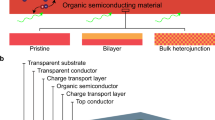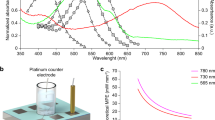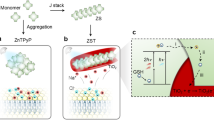Abstract
Neural activities can be modulated by leveraging light-responsive nanomaterials as interfaces for exerting photothermal, photoelectrochemical or photocapacitive effects on neurons or neural tissues. Here we show that bioresorbable thin-film monocrystalline silicon pn diodes can be used to optoelectronically excite or inhibit neural activities by establishing polarity-dependent positive or negative photovoltages at the semiconductor/solution interface. Under laser illumination, the silicon-diode optoelectronic interfaces allowed for the deterministic depolarization or hyperpolarization of cultured neurons as well as the upregulated or downregulated intracellular calcium dynamics. The optoelectronic interfaces can also be mounted on nerve tissue to activate or silence neural activities in peripheral and central nervous tissues, as we show in mice with exposed sciatic nerves and somatosensory cortices. Bioresorbable silicon-based optoelectronic thin films that selectively excite or inhibit neural tissue may find advantageous biomedical applicability.
This is a preview of subscription content, access via your institution
Access options
Access Nature and 54 other Nature Portfolio journals
Get Nature+, our best-value online-access subscription
$29.99 / 30 days
cancel any time
Subscribe to this journal
Receive 12 digital issues and online access to articles
$99.00 per year
only $8.25 per issue
Buy this article
- Purchase on Springer Link
- Instant access to full article PDF
Prices may be subject to local taxes which are calculated during checkout






Similar content being viewed by others
Data availability
The main data supporting the results in this study are available within the paper and its Supplementary Information. The raw and analysed datasets generated during the study are available for research purposes from the corresponding authors on reasonable request. Source data are provided with this paper.
Code availability
Custom codes used in this study are available at https://github.com/shengxingstars/2022-Si-diodes-modulation.
References
Won, S. M. et al. Emerging modalities and implantable devices for neuromodulation. Cell 181, 115–135 (2020).
Benfenati, F. & Lanzani, G. Clinical translation of nanoparticles for neural stimulation. Nat. Rev. Mater. 6, 1–4 (2021).
Patel, S. R. & Lieber, C. M. Precision electronic medicine in the brain. Nat. Biotechnol. 37, 1007–1012 (2019).
Chen, R., Canales, A. & Anikeeva, P. Neural recording and modulation technologies. Nat. Rev. Mater. 2, 16093 (2017).
Jiang, Y. & Tian, B. Inorganic semiconductor biointerfaces. Nat. Rev. Mater. 3, 473–490 (2018).
Tian, B. et al. Roadmap on semiconductor–cell biointerfaces. Phys. Biol. 15, 031002 (2018).
Spira, M. & Hai, A. Multi-electrode array technologies for neuroscience and cardiology. Nat. Nanotechnol. 8, 83–94 (2013).
Larson, C. E. & Meng, E. A review for the peripheral nerve interface designer. J. Neurosci. Methods 332, 108523 (2020).
Kobayashi, K. et al. Action of antiepileptic drugs on neurons. Brain Dev. 42, 2–5 (2020).
Zhang, R. & Wong, K. High performance enzyme kinetics of turnover, activation and inhibition for translational drug discovery. Expert Opin. Drug Dis. 12, 17–37 (2017).
Polikov, V. S., Tresco, P. A. & Reichert, W. M. Response of brain tissue to chronically implanted neural electrodes. J. Neurosci. Methods 148, 1–18 (2005).
Salatino, J. W. et al. Glial responses to implanted electrodes in the brain. Nat. Biomed. Eng. 1, 862–877 (2017).
Piech, D. K. et al. A wireless millimetre-scale implantable neural stimulator with ultrasonically powered bidirectional communication. Nat. Biomed. Eng. 4, 207–222 (2020).
Koo, J. et al. Wireless bioresorbable electronic system enables sustained nonpharmacological neuroregenerative therapy. Nat. Med. 24, 1830–1836 (2018).
Dmitriev, A. et al. Prediction of severity of drug–drug interactions caused by enzyme inhibition and activation. Molecules 24, 3955 (2019).
Athauda, D. & Foltynie, T. Drug repurposing in Parkinson’s disease. CNS Drugs 32, 747–761 (2018).
Grossman, N. et al. Noninvasive deep brain stimulation via temporally interfering electric fields. Cell 169, 1029–1041 (2017).
Blackmore, J. et al. Ultrasound neuromodulation: a review of results, mechanisms and safety. Ultrasound Med. Biol. 45, 1509–1536 (2019).
Christiansen, M. G., Senko, A. W. & Anikeeva, P. Magnetic strategies for nervous system control. Annu. Rev. Neurosci. 42, 271–293 (2019).
Li, L. et al. Colocalized, bidirectional optogenetic modulations in freely behaving mice with a wireless dual-color optoelectronic probe. Nat. Commun. 13, 839 (2022).
Maimon, B. E. et al. Spectrally distinct channelrhodopsins for two-colour optogenetic peripheral nerve stimulation. Nat. Biomed. Eng. 2, 485–496 (2018).
Tochitsky, I. et al. Restoring vision to the blind with chemical photoswitches. Chem. Rev. 118, 10748–10773 (2018).
DiFrancesco, M. L. et al. Neuronal firing modulation by a membrane-targeted photoswitch. Nat. Nanotechnol. 15, 296–306 (2020).
Shi, L. et al. Non-genetic photoacoustic stimulation of single neurons by a tapered fiber optoacoustic emitter. Light. Sci. Appl. 10, 143 (2021).
Duke, A. et al. Transient and selective suppression of neural activity with infrared light. Sci. Rep. 3, 2600 (2013).
Carvalho-de-Souza, J. L. et al. Photosensitivity of neurons enabled by cell-targeted gold nanoparticles. Neuron 86, 207–217 (2015).
Yoo, S., Park, J. H. & Nam, Y. Single-cell photothermal neuromodulation for functional mapping of neural networks. ACS Nano 13, 544–551 (2019).
Ghezzi, D. et al. A polymer optoelectronic interface restores light sensitivity in blind rat retinas. Nat. Photon. 7, 400–406 (2013).
Martino, N. et al. Photothermal cellular stimulation in functional bio-polymer interfaces. Sci. Rep. 5, 8911 (2015).
Jiang, Y. et al. Neural stimulation in vitro and in vivo by photoacoustic nanotransducers. Matter 4, 654–674 (2021).
Rand, D. et al. Direct electrical neurostimulation with organic pigment photocapacitors. Adv. Mater. 30, e1707292 (2018).
Jakešová, M. et al. Optoelectronic control of single cells using organic photocapacitors. Sci. Adv. 5, eaav5265 (2019).
Silvera-Ejneby, M. et al. Chronic electrical stimulation of peripheral nerves via deep-red light transduced by an implanted organic photocapacitor. Nat. Biomed. Eng. 6, 741–753 (2022).
Leccardi, M. et al. Photovoltaic organic interface for neuronal stimulation in the near-infrared. Commun. Mater. 1, 21 (2020).
Han, M. et al. Organic photovoltaic pseudocapacitors for neurostimulation. ACS Appl. Mater. Interfaces 12, 42997–43008 (2020).
Parameswaran, R. et al. Photoelectrochemical modulation of neuronal activity with free-standing coaxial silicon nanowires. Nat. Nanotechnol. 13, 260–266 (2018).
Jiang, Y. et al. Rational design of silicon structures for optically controlled multiscale biointerfaces. Nat. Biomed. Eng. 2, 508–521 (2018).
Tang, J. et al. Nanowire arrays restore vision in blind mice. Nat. Commun. 9, 786 (2018).
Jiang, Y. et al. Heterogeneous silicon mesostructures for lipid-supported bioelectric interfaces. Nat. Mater. 15, 1023–1030 (2016).
Han, M. et al. Photovoltaic neurointerface based on aluminum antimonide nanocrystals. Commun. Mater. 2, 19 (2021).
Rastogi, S. K. et al. Remote nongenetic optical modulation of neuronal activity using fuzzy graphene. Proc. Natl Acad. Sci. USA 117, 13339–13349 (2020).
Savchenko, A. et al. Graphene biointerfaces for optical stimulation of cells. Sci. Adv. 4, eaat0351 (2018).
Dipalo, M. et al. Intracellular action potential recordings from cardiomyocytes by ultrafast pulsed laser irradiation of fuzzy graphene microelectrodes. Sci. Adv. 7, eabd5175 (2021).
Eom, K. et al. Theoretical study on gold-nanorod-enhanced near-infrared neural stimulation. Biophys. J. 115, 1481–1497 (2018).
Carvalho-de-Souza, J. L. et al. Optocapacitive generation of action potentials by microsecond laser pulses of nanojoule energy. Biophys. J. 114, 283–288 (2018).
Wells, J. et al. Biophysical mechanisms of transient optical stimulation of peripheral nerve. Biophys. J. 93, 2567–2580 (2007).
Owen, S. F., Liu, M. H. & Kreitzer, A. C. Thermal constraints on in vivo optogenetic manipulations. Nat. Neurosci. 22, 1061–1065 (2019).
Wiegert, J. S. et al. Silencing neurons: tools, applications, and experimental constraints. Neuron 95, 504–529 (2017).
Schoen, I. & Fromherz, P. The mechanism of extracellular stimulation of nerve cells on an electrolyte-oxide-semiconductor capacitor. Biophys. J. 92, 1096–1111 (2007).
Benfenati, V. et al. A transparent organic transistor structure for bidirectional stimulation and recording of primary neurons. Nat. Mater. 12, 672–680 (2013).
Nitsche, M. A. et al. Transcranial direct current stimulation: state of the art 2008. Brain Stimul. 1, 206–223 (2008).
Sheng, X. et al. Design and non-lithographic fabrication of light trapping structures for thin film silicon solar cells. Adv. Mater. 23, 843–847 (2011).
Perkins, K. L. Cell-attached voltage-clamp and current-clamp recording and stimulation techniques in brain slices. J. Neurosci. Meth. 154, 1–18 (2006).
Cummins, T. et al. Voltage-clamp and current-clamp recordings from mammalian DRG neurons. Nat. Protoc. 4, 1103–1112 (2009).
Tremere, L. A. et al. Postinhibitory rebound spikes are modulated by the history of membrane hyperpolarization in the SCN. Eur. J. Neurosci. 28, 1127–1135 (2008).
Feyen, P. et al. Light-evoked hyperpolarization and silencing of neurons by conjugated polymers. Sci. Rep. 6, 22718 (2016).
Difrancesco, M. L. et al. A hybrid P3HT–graphene interface for efficient photostimulation of neurons. Carbon 162, 308–317 (2020).
Storm, J. F. Temporal integration by a slowly inactivating K+ current in hippocampal neurons. Nature 336, 379–381 (1988).
Shu, Y. et al. Selective control of cortical axonal spikes by a slowly inactivating K+ current. Proc. Natl Acad. Sci. USA 104, 11453–11458 (2007).
Kim, D. H. et al. Epidermal electronics. Science 333, 838–843 (2011).
Kang, S. K. et al. Bioresorbable silicon electronic sensors for the brain. Nature 530, 71–76 (2016).
Lu, L. et al. Biodegradable monocrystalline silicon photovoltaic microcells as power supplies for transient biomedical implants. Adv. Energy Mater. 8, 1703035 (2018).
Kang, S. K. et al. Dissolution chemistry and biocompatibility of silicon- and germanium-based semiconductors for transient electronics. ACS Appl. Mater. Interfaces 7, 9297–9305 (2015).
Jiang, Y. et al. Nongenetic optical neuromodulation with silicon-based materials. Nat. Protoc. 14, 1339–1376 (2019).
Hwang, S. W. et al. A physically transient form of silicon electronics. Science 337, 1640–1644 (2012).
Kathe, C. et al. Wireless closed-loop optogenetics across the entire dorsoventral spinal cord in mice. Nat. Biotechnol. 40, 198–208 (2022).
Okonogi, T. & Sasaki, T. Optogenetic manipulation of the vagus nerve. Adv. Exp. Med. Biol. 1293, 459–470 (2021).
Mathieson, K. et al. Photovoltaic retinal prosthesis with high pixel density. Nat. Photon. 6, 391–397 (2012).
Shemesh, O. A. et al. Temporally precise single-cell-resolution optogenetics. Nat. Neurosci. 20, 1796–1806 (2017).
Palanker, D. et al. Design of a high-resolution optoelectronic retinal prosthesis. J. Neural Eng. 2, S105 (2005).
Rotenberg, M. Y. et al. Silicon nanowires for intracellular optical interrogation with subcellular resolution. Nano Lett. 20, 1226–1232 (2020).
Metwally, S. & Stachewicz, U. Surface potential and charges impact on cell responses on biomaterials interfaces for medical applications. Mater. Sci. Eng. C 104, 109883 (2019).
Fu, H. et al. Morphable 3D mesostructures and microelectronic devices by multistable buckling mechanics. Nat. Mater. 17, 268–276 (2018).
Luo, Z. et al. Atomic gold-enabled three-dimensional lithography for silicon mesostructures. Science 348, 1451–1455 (2015).
Molokanova, E., Mercola, M. & Savchenko, A. Bringing new dimensions to drug discovery screening: impact of cellular stimulation technologies. Drug Discov. Today 22, 1045–1055 (2017).
Moon, E. et al. Bridging the ‘last millimeter’ gap of brain–machine interfaces via near-infrared wireless power transfer and data communications. ACS Photon. 8, 1430–1438 (2021).
Gaillet, V. et al. Spatially selective activation of the visual cortex via intraneural stimulation of the optic nerve. Nat. Biomed. Eng. 4, 181–194 (2020).
Nag, S. & Thakor, N. V. Implantable neurotechnologies: electrical stimulation and applications. Med. Biol. Eng. Comput. 54, 63–76 (2016).
Johnson, M. D. et al. Neuromodulation for brain disorders: challenges and opportunities. IEEE Trans. Biomed. Eng. 60, 610–624 (2013).
Zhao, S., Mehta, A. S. & Zhao, M. Biomedical applications of electrical stimulation. Cell. Mol. Life Sci. 77, 2681–2699 (2020).
Cheng, H. et al. Electrical stimulation promotes stem cell neural differentiation in tissue engineering. Stem Cells Int. 2021, 6697574 (2021).
Yao, G. et al. A self-powered implantable and bioresorbable electrostimulation device for biofeedback bone fracture healing. Proc. Natl Acad. Sci. USA 118, e2100772118 (2021).
Wang, L. et al. A fully biodegradable and self-electrified device for neuroregenerative medicine. Sci. Adv. 6, eabc6686 (2020).
Krawczyk, K. et al. Electrogenetic cellular insulin release for real-time glycemic control in type 1 diabetic mice. Science 368, 993–1001 (2020).
Rotenberg, M. Y. et al. Living myofibroblast-silicon composites for probing electrical coupling in cardiac systems. Proc. Natl Acad. Sci. USA 116, 22531–22539 (2019).
Scott, B. S. & Edwards, B. A. V. Electric membrane properties of adult mouse DRG neurons and the effect of culture duration. J. Neurobiol. 11, 291–301 (1980).
Zheng, J. H., Walters, E. T. & Song, X. J. Dissociation of dorsal root ganglion neurons induces hyperexcitability that is maintained by increased responsiveness to cAMP and cGMP. J. Neurobiol. 97, 15–25 (2007).
Chandrasekaran, K., Kainthla, R. C. & Bockris, J. O. An impedance study of the silicon-solution interface under illumination. Electrochim. Acta 33, 327–336 (1988).
Acknowledgements
This work was supported by the National Natural Science Foundation of China (NSFC) (61874064, to X.S.; 52171239, to L.Y.; and T2122010, to L.Y.), the National Key R&D Program of China (2018YFA0701400, to X.L.; 2017YFA0701102, to S.W.), the Beijing Municipal Natural Science Foundation (4202032, to X.S.), Tsinghua University Initiative Scientific Research Program (to X.S.), and the Center for Flexible Electronics Technology at Tsinghua University (to X.S. and L.Y.).
Author information
Authors and Affiliations
Contributions
Y.H. and X.S. developed the concepts. Y.H., H.W., Y.X., P.S. and X.F. performed material design, fabrication and characterization. Y.H., H.W., J.C., L.L. and X.S. performed numerical simulations. Y.H., Y.C., H.D., J.W., R.H., S.H., H.H., Y.D., X.F., S.W. and X.L. designed and performed biological experiments. L.Y., W.X., M.L., S.-H.S., S.W., X.L. and X.S. provided tools and supervised the research. Y.H. and X.S. wrote the paper in consultation with the rest of the authors.
Corresponding authors
Ethics declarations
Competing interests
The authors declare no competing interests.
Peer review
Peer review information
Nature Biomedical Engineering thanks Ravi Bellamkonda, Bozhi Tian and the other, anonymous, reviewer(s) for their contribution to the peer review of this work. Peer reviewer reports are available.
Additional information
Publisher’s note Springer Nature remains neutral with regard to jurisdictional claims in published maps and institutional affiliations.
Extended data
Extended Data Fig. 1
Schematic illustration of processing flow for the fabrication and transfer printing of doped silicon membranes.
Extended Data Fig. 2 Measurement of photocurrents induced by p+n and n+p Si diode films.
a, Scheme of the setup for the transient photoresponse measurement. The transient photocurrents are taken by voltage-clamp recording (filter at 10 kHz and sampled at 200 kHz) and the resistance of pipette is ~1 MΩ. Lightly doped surfaces (n-side for p+n Si, and p-side for n+p Si) contact the solution. b, The transient photocurrents generated on the Si surfaces, with pulsed light duration 500 ms and intensity 1.2 W cm−2. Most of the currents are photocapacitive, and negligible Faradic currents are observed.
Extended Data Fig. 3 Depolarized membrane current with the p+n Si film.
a, Scheme of the setup for the whole-cell recording of the DRG grown on p+n Si. b, Typical recorded membrane currents in response to the photostimulation with varying light intensities within a 10-s-long illumination, showing the slowly increased depolarized currents.
Extended Data Fig. 4 Hyperpolarized membrane current with the n+p Si film.
a, Scheme of the setup for the whole-cell recording of the DRG grown on n+p Si. b, Typical recorded membrane currents in response to the photostimulation with varying light intensities within a 1-s-long illumination (left), and enlarged details of the hyperpolarized currents (right).
Extended Data Fig. 5 Circuit model developed to understand the polarity-dependent photostimulation.
a, Scheme of the setup for the whole-cell patch clamp recording of DRG cells cultured on Si films. b, Equivalent circuit of the recorded membrane potential influenced by photovoltaic stimulations. Here we assume the cell has a hemispheric shape with a diameter of 30 µm. Rm1 = 66.9 MΩ, Rm2 = 33.45 MΩ, Cm1 = 27.3 pF, Cm2 = 54.6 pF, CSi = 70.7 pF and Rattach = 1.4 kΩ. The initial holding potential Vhold = −65 mV. c, Parameters used for photovoltages Vph generated by p+n and n+p Si films (taken from Fig. 1b,c), as well as transmembrane inward and outward currents Iin and Iout (taken and normalized from Extended Data Figs. 3 and 4), in response to various light intensities.
Extended Data Fig. 6 Simulation results based on the circuit model.
a,b, Inward (a) and outward (b) transmembrane currents (Iin and Iout) applied in the model, based on parameters in Extended Data Fig. 5. c, Calculated membrane voltages (Vm) responding to different inward and outward currents generated by p+n Si and n+p Si, respectively. d, Depolarized and hyperpolarized membrane voltages as a function of the light intensity. The simulation results are in good agreement with experiments in Fig. 2c,d.
Supplementary information
Supplementary Information
Supplementary figures.
Supplementary Video 1
Increased Ca2+ fluorescence in cultured DRGs evoked by a p+n Si film under optical stimulation.
Supplementary Video 2
Decreased Ca2+ fluorescence in cultured DRGs suppressed by an n+p Si film under optical stimulation. AMPA is initially applied for cell activation.
Supplementary Video 3
Evoked CMAPs and hindlimb lifting by exciting in the sciatic nerve with a p+n Si film under optical stimulation.
Supplementary Video 4
Decreased CMAPs and hindlimb lifting by inhibiting the sciatic nerve with an n+p Si film under optical stimulation.
Source data
Source Data
Source data for all figures.
Rights and permissions
Springer Nature or its licensor holds exclusive rights to this article under a publishing agreement with the author(s) or other rightsholder(s); author self-archiving of the accepted manuscript version of this article is solely governed by the terms of such publishing agreement and applicable law.
About this article
Cite this article
Huang, Y., Cui, Y., Deng, H. et al. Bioresorbable thin-film silicon diodes for the optoelectronic excitation and inhibition of neural activities. Nat. Biomed. Eng 7, 486–498 (2023). https://doi.org/10.1038/s41551-022-00931-0
Received:
Accepted:
Published:
Issue Date:
DOI: https://doi.org/10.1038/s41551-022-00931-0
This article is cited by
-
Monolithic silicon for high spatiotemporal translational photostimulation
Nature (2024)
-
Bioinspired nanotransducers for neuromodulation
Nano Research (2024)
-
An on-demand bioresorbable neurostimulator
Nature Communications (2023)



